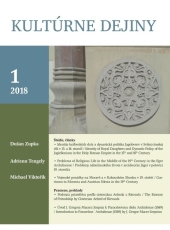Vojenské posádky na Moravě a v Rakouském Slezsku v 19. století
Garrisons in Moravia and Austrian Silesia in the 19th Century
Author(s): Michael ViktoříkSubject(s): History
Published by: VERBUM - vydavateľstvo Katolíckej univerzity v Ružomberku
Keywords: Moravia; Silesia; garrison; military history in 19th century; dislocation of an army; garrison cities
Summary/Abstract: The presented paper is a material study which purposely focuses on the narrow topic within the broad scope of military history. The aim is to answer the question about a number of troops in selected Moravian and Silesian areas, particularly in the first half of the 19 th century. This is not a marginal topic considering that the army represented an integral and many times also numerous part of the urban society, and naturally influenced the way of life, everydayness as well as economic relations not only in cities but also in rural areas. Despite the fact that many historians are aware of those relations, their works mention local garrison significantly less than we would have expected. The paper analyses the existing approach of researchers to the issue of determining a number of military garrisons in the Czech lands during the 19 th century and furthermore, limits and possibilities of primary sources (especially so called Dislokationstabellen) stored in the Austrian State Archive in ViennaTo establish the exact number of an army in a given year in a particular location is not as easy as it seems. The data about garrisons in literature dealing with urban history appears sporadically and they usually lack any kind of analysis. These data are usually taken from older literature, press or other types of sources, and their accuracy is questionable. The question regarding the number of the army in particular locations was not given a proper scope in Czech historiography. The majority of scholars was either content with varied illustrative data (which usually originated in the last three decades of the 19th century), or with a diversely long list of units active in the chosen city. To this day, there is a missing survey of the continuance of a garrison occupancy as well as their numbers in Bohemia and Moravia. The reason for the non-existence of such a survey is the lack of sources in local archives as well as the absence of research in specialized military archives. The up to day research showed that there are still many interesting sources, which are not often used in Czech research and which could help to answer some research questions. One of such sources are dislocation surveys (Detail-Dislokations-Tabelle), which were not found for the whole 19th century, but at least some decades of the first half of the century helped to give a coherent picture of the organization of the army in Moravia and Silesia, of the web of the most important towns and small towns where garrisons were placed, and it contained define numbers of particular local units. Even though these dislocation surveys are unique, the data should be carefully and critically analysed. Because of their character and structure, only some of these are usable for the acquirement of a number of soldiers in given localities. Another problem is also the stated number of soldiers in each locality. In the case of Moravia and Silesia, only the end of the year surveys survived, therefore there are none from the preceding months. Consequently, there is an absence of knowledge of how the number changed during the period and how the number varied in comparison to the actual quantity of the army. A probe into the vast fond of the general commando in Brno implies that there are important sources for a cognition of structural changes of chosen units during years, which could specify the published data in future. Despite the possible inaccuracy of the numbers with reality, I consider those sources yet the most exact in the relation to the number of Moravian and Silesian garrisons in the first half of the 19th century. The purpose of the study was not the transcription of the dislocation surveys, but to point out the potential of the so far unused sources and to focus chosen indicators in the sources in the analysis. The outcome of the attempt is a table, in which there is a data for each chosen year of the ten most numerous Moravian and Silesian garrison towns, including the exact number of the units. An exact structure for the strongest garrisons (Olomouc, Brno, and Opava) was created for the year 1846 and it also contains their numerical status. Potentially interested scholars can accordingly compile a similar structure of local garrisons, which were not contained in the text.
Journal: Kultúrne dejiny
- Issue Year: 9/2018
- Issue No: 1
- Page Range: 36-53
- Page Count: 18
- Language: Czech

